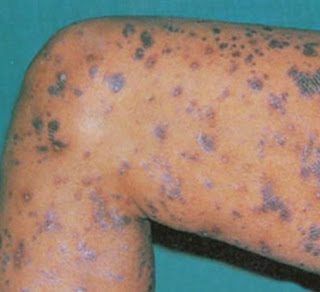Lichen Planus
Lichen planus is a common inflammatory disease of the skin presenting with characteristic violaceous, polygonal, pruritic papules. The disease may also affect the mucosa, hairs and nails. Lichen planus (LP) occurs worldwide with no racial predilection. Although the aetiology is unknown, immunopathological mechanisms are implicated in the pathogenesis of the dermatosis.
The rash is made up of shiny, 3-5 mm, slightly raised purple-red spots. A close look is needed to see the irregular white streaks that lie on the flat surface of some of them. The spots arise most often on the fronts of the wrists, around the ankles and on the lower back, but can spread more widely. In addition, lichen planus sometimes comes up in lines where the skin has been scratched or cut.
Other types of lichen planus include a thickened ('hypertrophic') lichen planus, which tends to affect the shins, and a ring-shaped ('annular') lichen planus, which usually comes up in the creases such as the armpits. Lichen planus occasionally appears on the scalp where it can cause hair loss, or may damage the nails (thinning and grooving of the nail plate), though this is rare.
Lichen planus is common in the mouth and is present in about 30-70% of those who have it on their skin.
Lichen planus can affect the penis in men, causing purple-coloured or white ring-shaped patches. Unlike other patches of lichen planus, these often do not itch. Lichen planus can affect the genital area in women too, but this is less common.
Lichen planus in most patients clear up within 18 months and usually stay clear, although some have a second episode many years later. Unfortunately some types of lichen planus, such as oral, hair or nail involvement, can last for many years. Even after the active lichen planus has cleared up, pigmented stains in the skin may persist for a long time, particularly in Asian or Afro-Caribbean skin.
Symptom
The symptoms of lichen planus of the skin are:
* purple-red coloured bumps (papules) that are slightly raised and shiny and have a flat top
* the papules usually measure 3-5mm in diameter
* the papules may also have irregular white streaks (Wickham's striae)
* thicker scaly patches can appear, usually around the ankles; this is known as hypertrophic lichen planus
* itchy skin
Lichen planus of the skin often affects the wrists, ankles and lower back, although other parts of the body can also be affected.
Thickened (hypertrophic) lichen planus affects the shins and ring-shaped lichen planus affects creases in the skin, such as the armpits. After the lesions have cleared, the affected area of skin can sometimes become discoloured.
The symptoms of lichen planus of the mouth are:
· a white pattern on the tongue and inner cheeks
· white and red patches in the mouth
· burning and discomfort in the mouth while eating or drinking
· painful, red gums
· recurring mouth ulcers
Mild cases of oral lichen planus do not usually cause any pain or discomfort.
The symptoms of lichen planus of the penis are:
· purple or white ring-shaped patches on the tip of the penis (glans)
· bumps (papules) that are flat-topped and shiny
· the rash is often not itchy
Lichen planus of the vulva and vagina
The symptoms of lichen planus of the vulva and vagina include:
· soreness, burning and rawness around the vulva
· the vulva may be covered in white streaks and be a red, pink or pale white colour
· if the vagina is affected, sexual intercourse can be painful
· if the outer layers of skin break down, moist, red patches can form
· scar tissue can form, which distorts the shape of the vagina
· a sticky, yellow or green discharge can form, which may be bloodstained
· the opening of the vagina can become narrowed
Treatment
The first line of treatment is represented by oral antihistamines and flourince dermato-corticosteroids;
A second choice therapy is the systemic corticosteroid therapy (0.25 – 0.5 mg / kg Predison) for 3-4 weeks if there are no obvious contraindications, and retinoids, 40-80 mg weekly, in intramuscular injection and triamcinolone acetonide, for 6-8 weeks;
For severe forms of lichen planus, treatment should be intensive, it starts with a topical steroid, then is choosen another treatment option (corticosteroids, cyclosporine, topical and systemic retinoids, immune suppressants).



No comments:
Post a Comment